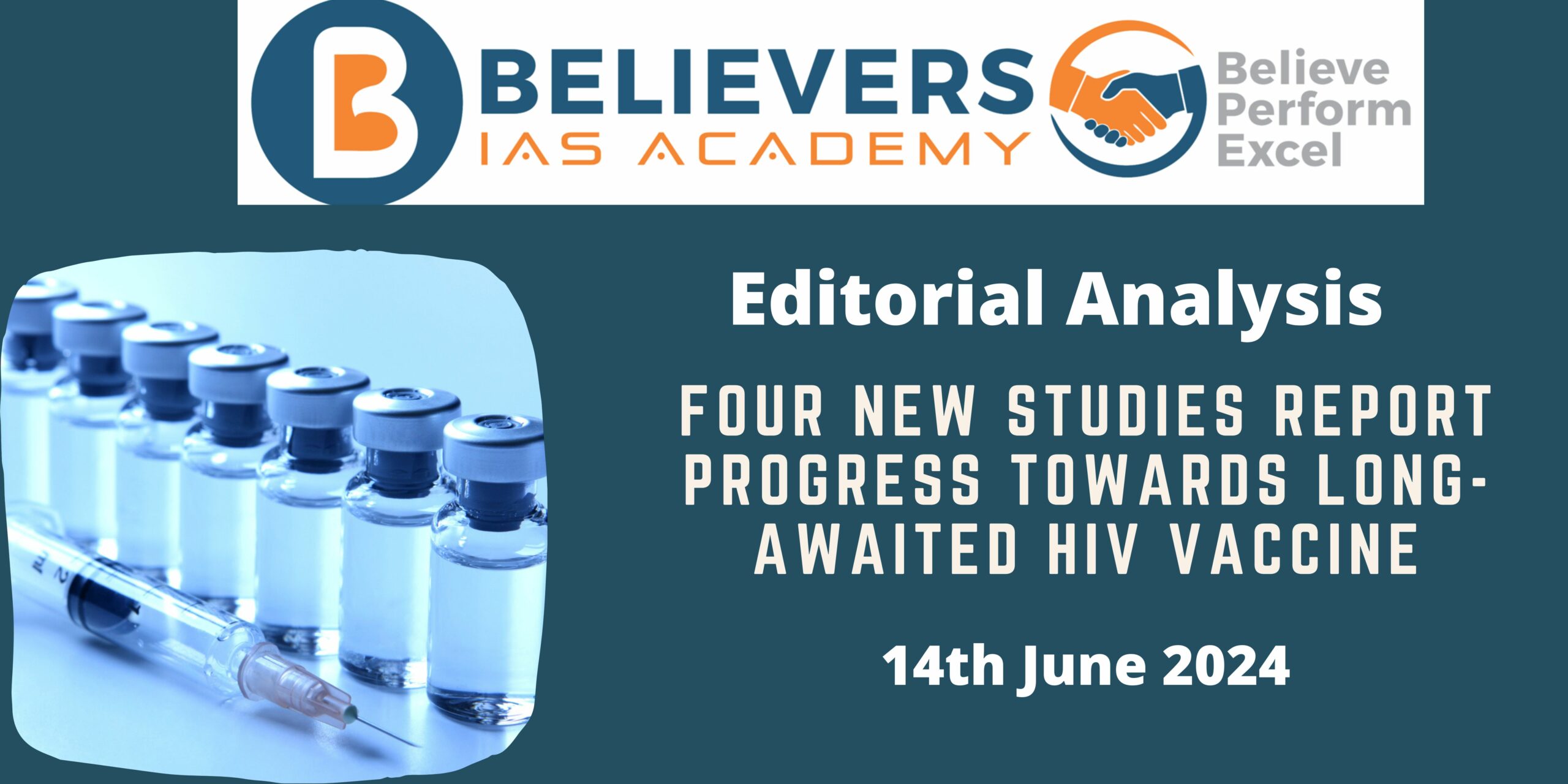Four new studies report progress towards long-awaited HIV vaccine
Context
In early 1981, Dr. Michael Gottlieb, an assistant professor at UCLA Medical Center, sought to teach immunology principles to a post-doctoral fellow. This pursuit led to the identification of a patient with pneumocystis pneumonia and sudden, unexplained weight loss.
- As more similar cases emerged, Dr. Gottlieb published a paper in the Morbidity and Mortality Weekly Report, unknowingly documenting the first cases of acquired immunodeficiency syndrome (AIDS).
- Nearly half a century later, AIDS remains without a vaccine or cure, posing a significant challenge to global health.
Relevance
GS-02 Health
Dimensions of the Article:
- The Background: History of HIV Vaccine
- Why is the Need for an HIV Vaccine?
- What is HIV?
- About the Progress: Broadly Neutralizing Antibodies (bNAbs)
- Why Address this Issue?
The Background: History of HIV Vaccine
- The quest for an HIV vaccine has been fraught with challenges since the first cases of AIDS were reported.
- Unlike other infectious diseases, where vaccines have successfully been developed, HIV has proven to be exceptionally elusive. The primary hurdle is the virus’s high mutation rate, leading to a vast number of variants.
- The replication process of the human immunodeficiency virus (HIV) is error-prone, generating multiple strains that complicate vaccine development.
- This genetic diversity surpasses even that of influenza, which is notorious for its variability.
- Initial attempts focused on traditional vaccine approaches, such as inactivated viruses and protein subunits, but these methods failed to elicit a robust immune response.
- The discovery of broadly neutralizing antibodies (bNAbs) in the early 1990s provided a glimmer of hope. These antibodies could target conserved regions of the virus that were less prone to mutation, offering a potential pathway to an effective vaccine.
Why is the Need for an HIV Vaccine?
- High Global Prevalence: HIV/AIDS affects millions worldwide, with a significant burden in sub-Saharan Africa. An effective vaccine could drastically reduce the number of new infections.
- Treatment Limitations: Current antiretroviral therapies (ART) can manage but not cure HIV. Patients must adhere to lifelong treatment, which can be costly and have side effects.
- Transmission Prevention: A vaccine would be a powerful tool in preventing the spread of HIV, especially in high-risk populations.
- Economic Impact: The economic burden of HIV/AIDS is substantial, affecting healthcare systems and economies, particularly in low-income countries.
- Quality of Life: An HIV vaccine would improve the quality of life for millions, reducing stigma and the psychological burden associated with the disease.
- Future Generations: A vaccine would protect future generations from HIV, moving towards the goal of an HIV-free world.
What is HIV?
- HIV, or Human Immunodeficiency Virus, is a virus that attacks the body’s immune system, specifically the CD4 cells (T cells), which are crucial for immune response.
- Some important points about HIV:
- HIV is a retrovirus that integrates its genetic material into the host cell’s DNA, making it challenging to eradicate.
- It targets and destroys CD4 cells, weakening the immune system and making the body vulnerable to opportunistic infections and certain cancers.
- HIV is primarily spread through bodily fluids, including blood, semen, vaginal fluids, and breast milk.
- It is commonly transmitted via unprotected sex, needle sharing, and from mother to child during childbirth or breastfeeding.
- Stages of Infection:
- The infection progresses through stages: acute infection, clinical latency, and AIDS.
- Without treatment, HIV can lead to AIDS, where the immune system is severely compromised.
- Symptoms and Diagnosis:
- Early symptoms resemble flu-like illness. Diagnosis is confirmed through blood tests detecting HIV antibodies or antigens.
- While there is no cure, antiretroviral therapy (ART) can suppress the virus, allowing the immune system to recover and reducing the risk of transmission.
- Global Impact: HIV/AIDS has caused millions of deaths and continues to be a significant public health challenge worldwide.
About the Progress: Broadly Neutralizing Antibodies (bNAbs)
- The discovery of broadly neutralizing antibodies (bNAbs) in a subset of HIV-infected individuals marked a significant breakthrough.
- These antibodies can neutralize a wide range of HIV strains by targeting conserved regions of the virus that are less likely to mutate. However, developing a vaccine that can elicit these bNAbs in the general population has been challenging due to several factors:
- Generation Time: It takes years for the body to produce bNAbs naturally, by which time the virus has evolved to escape them.
- Rarity of B-cells: The B-cells that can produce bNAbs are rare, making it difficult to stimulate them through vaccination.
- Vaccine Design: Designing a vaccine that can guide the immune system to produce bNAbs involves a complex, multi-step process known as germline targeting.
- Recent research has made progress in the first two steps of germline targeting. Two promising vaccine candidates, N332-GT5 and eOD-GT8, have shown the ability to engage the right B-cells and initiate the production of bNAbs. These candidates have demonstrated efficacy in animal models and are currently undergoing phase-1 clinical trials in humans.
Suggested Measures
- Increased Funding: Allocate more resources to HIV research, focusing on vaccine development, innovative treatment strategies, and preventive measures.
- Collaborative Research: Foster collaboration between researchers, institutions, and governments worldwide to share knowledge and accelerate progress.
- Public Awareness: Enhance public awareness about HIV prevention, testing, and treatment to reduce stigma and encourage early diagnosis and management.
- Policy Support: Implement supportive policies that ensure access to healthcare, ART, and preventive services for all populations.
- Strengthen Healthcare Systems: Build robust healthcare systems capable of delivering comprehensive HIV care and supporting vaccine distribution once available.
- Community Engagement: Involve communities in research efforts and decision-making processes to ensure culturally sensitive and effective interventions.
Way Forward
- Continue investing in cutting-edge research to understand the virus better and develop innovative vaccines and treatments.
- Strengthen global partnerships to leverage expertise, resources, and infrastructure in the fight against HIV/AIDS.
- Implement comprehensive education programs to promote safe practices and reduce the spread of HIV.
- Ensure equitable access to prevention, testing, and treatment services, especially in underserved and high-risk populations.
- Establish robust systems for monitoring and evaluating the effectiveness of interventions and adjusting strategies as needed.
- Secure sustainable funding sources to support long-term HIV/AIDS programs and research initiatives.



